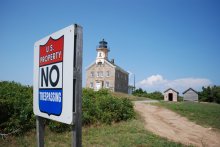New York Monsters Myths
 The ferry horn pierces the thick morning fog between Orient Point at the North Fork’s tip and Plum Island, where jet black Great Cormorants perched atop wooden pilings crane their crooked necks to spy visitors aboard the mostly empty boat as it sails into Plum Gut Harbor.
The ferry horn pierces the thick morning fog between Orient Point at the North Fork’s tip and Plum Island, where jet black Great Cormorants perched atop wooden pilings crane their crooked necks to spy visitors aboard the mostly empty boat as it sails into Plum Gut Harbor.
After passing through barbed-wire fences, being searched by Department of Homeland Security (DHS) agents, agreeing not to photograph secure areas and signing affidavits promising to “avoid contact with cattle, sheep, goats, deer and…swine for…5 days, ” a small pack of journalists—including this reporter, who first requested a tour years ago—board a navy blue school bus for the two-minute ride to the Plum Island Animal Disease Center.
The lab, which last year created a new vaccine that researchers hope will help eradicate foot-and-mouth disease in livestock worldwide, is lifting the veil on their secretive setup as the feds work to move it to Kansas in the coming decade—a plan that has set off a tug-of-war between New York and Midwestern lawmakers. And since the plan includes selling the 843-acre Island to offset the $1.2-billion cost of building a new lab that will research into incurable airborne deadly animal-to-human diseases, beyond Plum Island’s purvue, it couldn’t hurt to dispel the many conspiracy theories that roll ashore.
Montauk Monsters and chronic Lyme disease supposedly escaped from the mysterious pork chop-shaped island Nelson DeMille and others wrote books about. An unidentified man with “very long fingers” and recent brain surgery scars washed up dead here in 2010, sparking suspicions the lab’s scientists were experimenting on humans. And some claim that a top Nazi virologist helped the U.S. Army develop biological weapons after World War II before the Department of Agriculture took over the original lab in the 1950s.
“We didn’t have anything to do with any of those, ” Dr. Lawrence Barrett, the lab director who maintains the Montauk Monster was just a decomposing dog, says in his Oklahoma accent, as the tour passes the old lab, called Building 257. He blasts a 2004 book on it by Michael Carroll, but not by name, adding that no photos are allowed of the century-old white structure with a slaughterhouse-style cattle chute for test cows that were penned outside.
The current lab, which opened two decades ago, keeps the animals inside to avoid a potential outbreak blowing in the wind.
“What we’re most worried about is an agent getting off this island, ” Barrett says, referring to the stringent protocols to prevent the release of diseases.
Construction is slated to start next year at Plum Island’s replacement, the new National Bio and Agro-Defense Facility, joining four nationwide biosecurity level (BSL) 4 facilities with airlocks, space suits and vacuum rooms designed for researching fatal exotic aerosol-transmitted infections without vaccines, like Ebola. Plum Island is a BSL 3 lab with similarly stringent protocols that require anyone leaving to shower first, where one scientist set a record of 11 showers in one day.
бэтбум
You might also like

|
November's Chopin Deluxe Ruby Studded Boomerange Style Pendant Chunky Princess Necklace Jewelry (November's Chopin)
|





